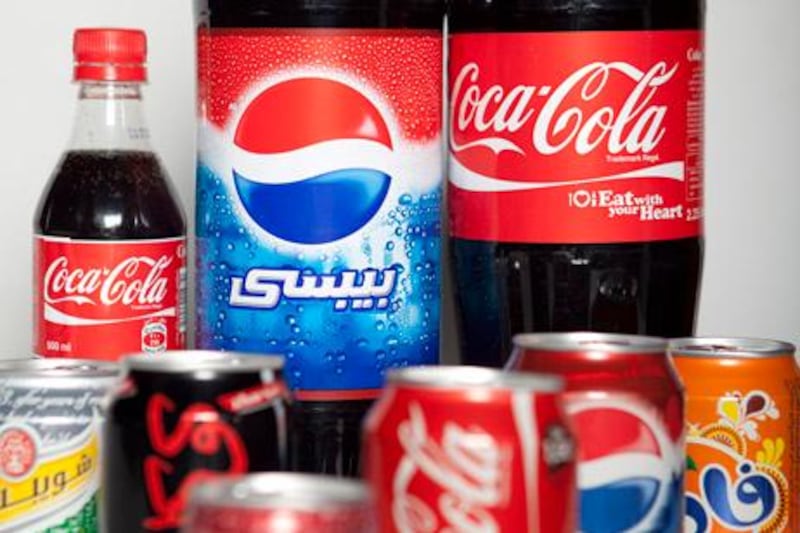Coca-Cola has long been the one of the best bargains in the UAE, resilient in the face of 20 years of change and growth in the country, as well as the company - until this week.
1988
The price of a 330ml can of Coca-Cola and Pepsi is fixed at Dh1. Emirates Golf Club is in the final stages of construction on desert land near Dubai. Parts of the historic Bastakiya are threatened with demolition. The Iran-Iraq War ends with 1.5 million dead. The average house price in London is £125,000 (Dh724,000). Crude oil is US$15 a barrel. A gallon of petrol in the United States is 91 cents. Sugar is trading in New York at US$0.15 a pound.
1991
The Arab League officially ends a boycott of Coca-Cola and Pepsi imposed because the companies did business with Israel. The boycott had been largely ignored for two years, with bottling plants opening in a number of Gulf nations and Coke sponsoring a World Youth Soccer Tournament in Saudi Arabia. Syria, however, does not end its boycott until 2005.
1993
Coca-Cola re-enters the Indian market after an absence of 16 years caused by the company's refusal to sell a share of its Indian operations to a local company. In its place, two brothers, Ramesh and Prakash Chauhan, launch Thums Up with the slogan "Happy days are here again". In 1993, Coke buys Thums Up for US$60m and the brand largely disappears from the market. Two years later it is relaunched with a more macho and youthful image designed to weaken Pepsi's market share and is so successful that Thums Up is now the most popular cola drink in the country; it has been sold in the UAE since 2007.
1995
First introduced in the early 1970s, the one-dirham coin shrinks to its current size, although the dallah, or coffee pot, design remains unchanged. The 50 fils coin also shrinks and becomes seven-sided. Vending machines across the nation have to be changed.
2002
Mecca Cola is launched in France by Tawfik Mathlouthian, a businessman, as an alternative for Muslims who do not want to consume an American-owned product. A percentage of profits is given to Palestinian and Islamic charities. Using the slogan "No more drinking stupid, drink with commitment", the drink is sold across the Middle East and the company eventually relocates to Dubai. Its initial popularity - and lower price than either Coke or Pepsi - led to an ambitious plan to open a major production plant in Dubai Industrial City in 2007. Mecca Cola does not seem to be currently available in the UAE, though; the company's website is under maintenance and its phones are inactive.
2004
Dubai Refreshments Co completes a major refurbishment of its plant on Sheikh Zayed Road, a local landmark since the 1960s. DRC has been the sole franchisee and distributor for Pepsi, which first arrived in the region in the early 1950s. It has always outsold Coke, at one stage capturing 95 per cent of the local market. In Saudi Arabia, Coke is even known as "Red Pepsi". But a more aggressive marketing strategy is closing the gap almost to parity. Sales of carbonated drinks in the region are said to have doubled in the past 10 years and are now worth more than US$830m annually.
2005
Coca-Cola signs a 16-year extension of its official sponsorship deal with Fifa. The agreement will cover the Fifa Club World Cup in Abu Dhabi in 2009 and 2010 and the 2022 World Cup, which is eventually awarded to Qatar.
2007
Coca-Cola announces a major water-conservation programme to compensate for the estimated 346 billion litres it uses to produce soft drinks worldwide. The company pledges to "return every, every drop we use back to nature". Researchers for WWF estimate that the amount of water needed to produce the sugar alone for a litre of Coke is between 175 and 250 litres. The average yearly rainfall for the coastal region of the UAE is less than 120mm.
2008
Coke creates a special can for Ramadan decorated with a crescent moon and a star for Muslim countries. The company has long been the victim of unfounded rumours in the region, including one in Egypt that claimed that the label contained hidden anti-Islamic phrases. Among those refuting the allegations is the grand mufti in Cairo, who notes that he drinks a can of Coke a day and that the drink "does not injure Islam or Muslims".
January 2011
The price of a 330ml can of Coca-Cola and Pepsi Cola rises to Dh1.50. A can of Coke contains 10.6 grams of sugar. The price of sugar is 32 cents a pound. Crude oil is pushing US$100 a barrel. The average price of house in London is £430,000 (Dh2.4 million). A gallon of petrol in the US is $3.10. A spokesman for Coke in the UAE says: "For more than 20 years, Coca-Cola products were sold for the same price; there are no other consumer products which kept the same price for more than two decades."







